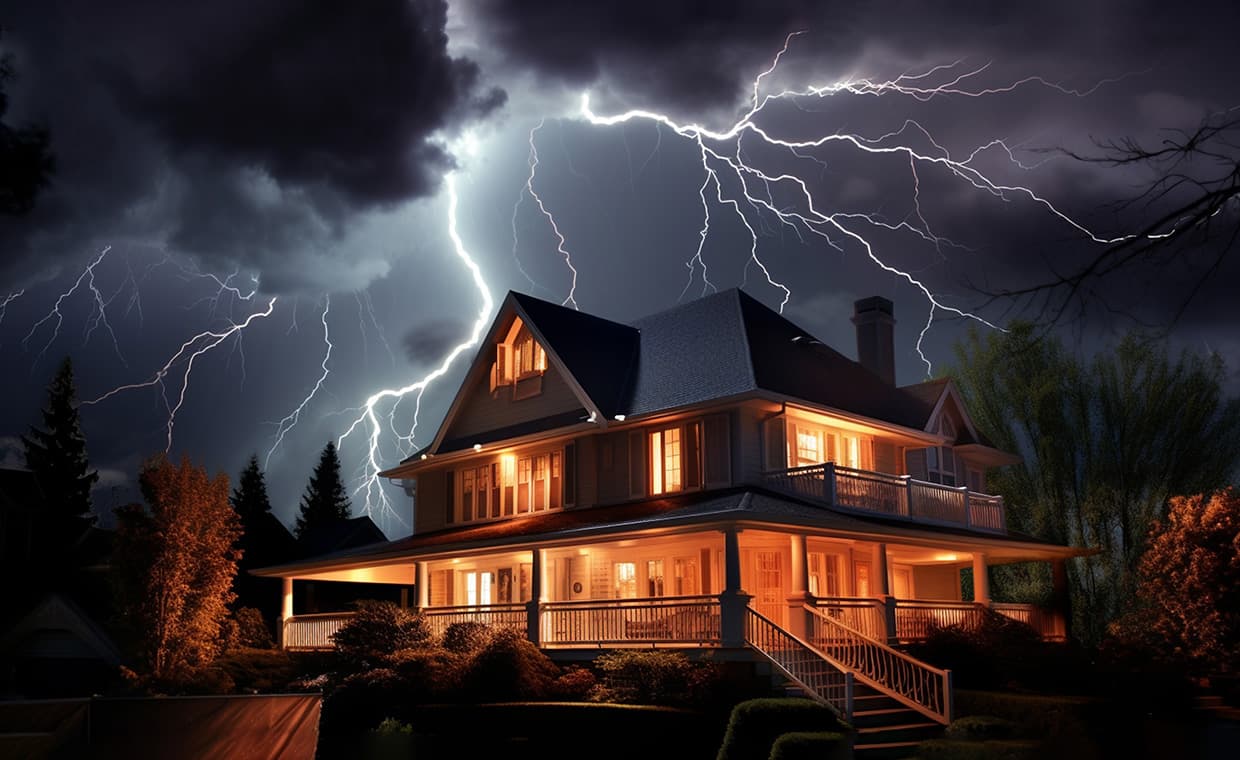
Extreme weather events, such as hurricanes, tornadoes, heavy snow, and hailstorms, can cause significant damage to your home, with the roof being particularly vulnerable. Storm-proofing your roof for these events is paramount to minimize damage and ensure the safety of your home and family. We will explore practical steps you can take on how to prepare your roof for extreme weather, helping you safeguard your property against nature’s unpredictable forces. If you are looking for a professional, 1 OAK Roofing Marietta is the Best Roofing Contractor for Repairs.
Tips for Storm-Proofing Your Roof
Following are the steps to prepare roof for extreme weather:
01. Conduct a Thorough Roof Inspection

The first step in storm-proofing your roof is to conduct a thorough inspection. This should be done well before any anticipated weather events to allow ample repair time. Start by examining the roof from the ground using binoculars, then, if safe, move closer to inspect for damaged, loose, or missing shingles. Look for signs of wear and tear, such as cracks, curling, or buckling shingles, and any areas where the roofing material has deteriorated. Additionally, inspect the flashing around chimneys, vents, and skylights for signs of damage or gaps that could allow water penetration. Identifying and addressing these issues early can prevent further damage during severe weather.
02. Clean and Maintain Gutters and Downspouts

Clean and well-maintained gutters and downspouts protect your roof during extreme weather. Gutters clogged with leaves, debris, or ice can cause water to back up and seep under the roofing materials, leading to leaks and structural damage. Regularly clean your gutters and downspouts to ensure they are free of obstructions and capable of directing water away from your home. Inspect for any signs of damage or sagging, and repair or replace sections as needed. Installing gutter guards can help prevent debris buildup and reduce the frequency of cleaning. Properly functioning gutters and downspouts prevent water damage to your roof and home’s foundation.
03. Trim Overhanging Trees and Branches

Overhanging trees and branches pose a significant risk to your roof during extreme weather events. High winds, heavy snow, or ice can cause branches to break and fall onto your roof, causing damage to shingles, flashing, and even the roof structure itself. To mitigate this risk, trim any trees or branches that overhang or are near your roof. Regular pruning protects your roof and promotes the health of your trees. If you need clarification about the safety of certain branches or the proper way to trim them, consider hiring a professional arborist to assess and address the issue.
Follow these tips when trimming trees:
5 Tips For Trimming Trees Correctly
04. Secure Loose Roof Materials For a Storm Proof Roof

Securing loose roof materials is a paramount step to get hurricane-proof roof. High winds can easily lift loose shingles, tiles, or metal panels, causing further damage to the roof and potentially becoming hazardous debris. Inspect your roof for loose materials and properly secure them using appropriate fasteners or adhesives. Pay special attention to areas around the edges of the roof and the ridge, as these are particularly susceptible to wind uplift. Ensuring that all roofing materials are securely attached will help your roof withstand extreme weather.
05. Reinforce Roof Structures

Reinforcing your roof structures can provide additional protection against extreme weather. This may involve adding hurricane straps or clips to secure the roof to the walls of your home more effectively. These metal connectors can significantly increase the wind resistance of your roof, reducing the risk of it being torn off during a storm. Additionally, consider reinforcing the roof deck by adding more nails or using adhesive to secure the plywood more firmly. Strengthening the structural integrity of your roof can help it withstand the high winds and heavy loads linked with severe weather events.
06. Inspect and Replace Roof Sealants

Roof sealants play a critical role in preventing water penetration and maintaining the integrity of your roof. Over time, sealants can deteriorate due to exposure to the elements, becoming cracked or brittle. Inspect all roof sealants around flashing, vents, chimneys, and other penetrations to ensure they are in good condition. If you notice any signs of wear or damage, replace the sealant promptly to maintain a watertight barrier. Using high-quality, weather-resistant sealants can provide added protection against extreme weather conditions and prolong the life of your roof.
07. Install Roof Ventilation Systems

Proper roof ventilation is paramount for maintaining the health and durability of your roof. During extreme weather events, inadequate ventilation can usher in the attic’s buildup of heat and moisture, causing damage to the roofing materials and the underlying structure. Ensure your roof has adequate ventilation through ridge vents, soffit vents, or gable vents. Proper ventilation helps regulate temperature and moisture levels, reducing the risk of ice dams, mold growth, and other weather-related issues. Installing or upgrading your roof ventilation system can improve the overall resilience of your roof and make your roof a storm-proof roof.
08. Prepare for Snow and Ice

Preparing your roof for these conditions is crucial in regions prone to heavy snow and ice. Snow accumulation can add significant weight to your roof, leading to structural stress or collapse. Ensure that your roof can handle the typical snow load for your area by consulting with a structural engineer if necessary. Install snow guards or snow retention systems to prevent large amounts of snow from sliding off your roof suddenly, which can cause damage or injury. Proper attic insulation and ventilation should also be ensured to prevent ice dams. Ice dams occur when heat from the attic melts snow on the roof, refreezing the eaves and causing water to back up under the shingles. Preventing ice dams can protect your roof and reduce the risk of water damage.
Takeaway
Storm-proofing your roof for extreme weather events involves a combination of proactive inspections, maintenance, and upgrades. You can significantly enhance your roof’s resilience by conducting thorough roof inspections, maintaining gutters and downspouts, trimming overhanging branches, securing loose materials, reinforcing structures, and ensuring proper ventilation. Additionally, preparing for snow and ice, considering impact-resistant materials, reviewing your insurance policy, creating an emergency repair kit, and developing a maintenance plan can provide comprehensive protection against nature’s unpredictable forces. These measures on how to prepare a roof for extreme weather will help safeguard your home, minimize damage, and ensure your family’s safety during extreme weather events.
Also check for signs if your roof needs replacement, before any major storm:






























